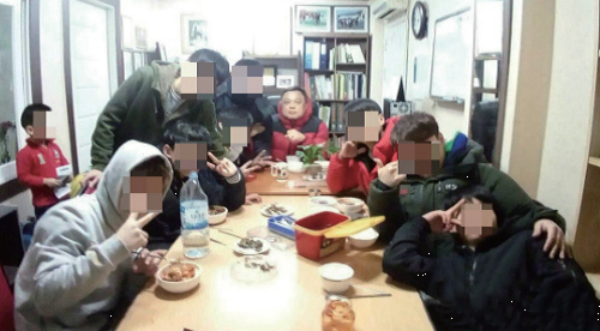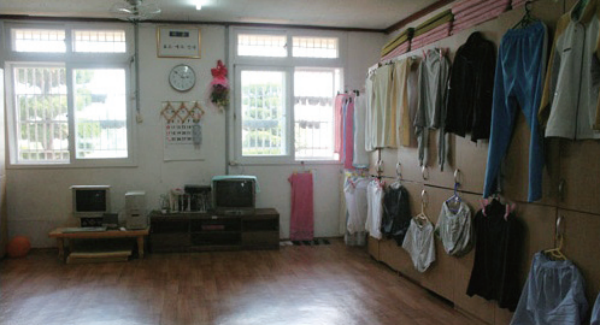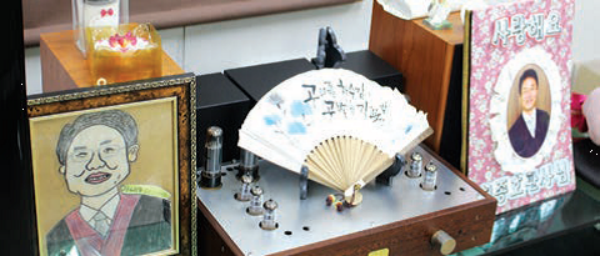Minsu (false name), 19, wakes up at 6am, makes his bed, and starts to make breakfast for his younger brothers. This scene might seem pretty ordinary, but Minsu and his brothers have special experience of standing before a court. The place Minsu lives is called a youth recovery center, a group home where about ten youth offenders who have received a protective disposition live together. The Sungkyun Times (SKT) now explores the past and the present of the Youth Recovery Center, and interviews the judge who developed the idea for the Youth Recovery Center.
Advent of the Youth Recovery Center
What is a Youth Recovery Center?
In Korea, a teenager who has committed a crime must go through the usual legal proceedings until he or she receives punitive action or a protective disposition. If one receives the former, then they must go to the juvenile reformatories, while there are many ways to treat the latter. A protective disposition consists of ten levels, and a judge can issue many dispositions together. The higher the number, the worse the severity of the crime is justied to be. A teenager who gets a No.1 is recommended for care and custody to a person who is considered to be a guardian. A youth recovery center is an alternative home that accommodates protected juveniles who cannot be raised properly because of a broken family. If a private family appointed by a court arranges a house and creates it a cohabitation space, a judge can choose to entrust the juvenile delinquent to the private family who then becomes the guardian. Protected juveniles can often be fostered more soundly in the center than their original homes. The purpose of the center is to look after, advise, and educate protected juveniles to guide them toward a better future. In other words, a youth recovery center is a place that can be an alternative to juvenile reformatory which is more of a closed world.
Past and the Present of Youth Recovery Centers
In October 2010, the first youth recovery center Shalom Youth Center opened in Gyeongsangnam-do, Korea, thanks to the efforts of Chun Jong-Ho, a chief judge at a Busan Family Court. 18 more centers in Ulsan, Daejeon, and Chungcheongnam-do have opened since then, and about 160 protected juveniles are now living in the 19 centers. Despite the increase in youth centers, it has become more difcult to operate a youth recovery center because of nancial problems. Even though judge Chun provided some support through the royalties he earned from his books on the subject of juvenile delinquency, as well as private donations, it was not sufcient enough to improve the situation. Therefore, Judge Chun appealed for legislation in order to create a better state for youth recovery centers, and required 13 members of the National Assembly to revise the bill that claimed legal and institutional support to the centers. The revised bill was approved, and it is now possible for the center to receive nancial support from the government.

Why are Youth Recovery Centers Necessary?
Prevention of Repeated Crime
The Korean Institute of Criminology conducted a study of 946 people who were released from Seoul Juvenile Training School between 1983 and 1985. They traced and analyzed any of their future crimes until June 1994, and found that the number of crimes committed in youth was the most significant factor to make juvenile delinquents become adult criminals. The research result showed that prevention of a second crime is crucial. The youth recovery center is effective for preventing repeated crimes. According to research by Judge Chun, three people committed a second conviction among the 21 protected juveniles at the Shalom Youth Center from November 2010 to July 2012. This means that only 14.3% were second offenders. Considering that the repeated crime rate of young offenders is 37%, this figure is noticeably low.
Poor conditions of Youth Facilities
There are many limitations for putting juvenile delinquents into juvenile reformatory to prevent repeated crimes since many Korean youth facilities are in poor conditions. According to the Ministry of Justice, approximately 10 to 17 juvenile delinquents are accommodated in one room of a juvenile reformatory. This is because the number of juvenile delinquents exceeds the fixed number of the center. For example, there are 155 people in juvenile reformatory in Anyang, although the xed number of people to be accommodated is 80. Therefore, there are ten female juvenile delinquents living together in a room of 13.2㎡. Korean youth facilities have poor conditions compared to other countries such as Japan that accommodate three or four people in a room and other developed countries that strictly keep to single occupancy. The condition of the Juvenile Classication Review Board where juvenile delinquents have to stay until they receive their final judgment is worse. There is only one Juvenile Classification Review Board in Korea so that the rest borrow a corner of juvenile reformatories. Moreover, there are only seven places that play the role of the Juvenile Classification Review Board including those that have borrowed a corner of the juvenile reformatories.

Limitations of Original Home
Except for juvenile reformatory, a home is a place to care for juvenile delinquents. Statistically, however, most juvenile delinquents are from single parent families or low income families. For example, among the protected juveniles in Changwon District Court from March 2010 to March 2011, 46.54% of the juveniles were from single parent families, and more than 50% of the juveniles were from low income families among the rest. Furthermore, the repeated crime rate of juvenile delinquents from single parent families is 57%. Teenagers’ running away from home is often affected by family troubles. In this atmosphere, sending them back to their homes is no better than negligence, and it is an obligation of the nation and society to provide them with a warm and safe house that can offer them protection on 24 hours.
Interview
Chun Jong-Ho, chief judge of the Busan Family Court, is known as the “father of juvenile delinquents”. He has made a huge effort to help reform young offenders, and is still making steady and persistent efforts.

1. Please introduce yourself.
I am Chun Jong-Ho, chief judge at a Busan Family Court. I have been working as a judge for 21 years, and it has been eight years since I started working for the juvenile department of the Family Court. I was assigned to Changwon District Court to handle juvenile cases eight years ago, and I worked constantly to revise institutions that must be changed since then.
2. What were the signicant factors that made you decide to develop youth recovery center? How do juveniles in youth recovery center spend their days? According to statistics, there were a hundred thousand juvenile delinquencies in 2010, and 45 thousand of those came into court. Depending on their delinquency degree, they were sent to a home, juvenile reformatories, or prison. Most were sent to a home, but they were mostly from single parent families or low income families. Since they cannot be cared for in their home or cannot get money from parents, many will repeatedly commit crimes such as theft. For these reasons, the situation does not change even though I let juvenile delinquents into a home. As an alternative to a home, I suggested to make a group home for juvenile delinquents. In youth recovery centers, about ten juvenile delinquents, a man, and wife, live together as in a typical family home. Juvenile delinquents go to school, go to qualication exam academies, do part-time jobs and so on. If there is a school event, the man and wife participate in those events as parents. Some of youths go to their original home since it is possible on weekends.
3. You have focused on reformation of juvenile delinquents. How could you get close to them even though you are from an older generation? Do you have any special ways to communicate with them?
To juveniles, I am ‘a guy with two faces.’ I scold sternly in court, but I treat them as young adults after taking off my judge’s robe. Some of them feel awkward facing my attitude, but I treat them naturally because I want them to be fostered as a sound member of society. I also use some words teenagers use when I talk with them. Moreover, I started a soccer team, and we get along together by exercising every Thursday.
4. It is true that the management of the Youth Recovery Center has been improved, but it still has limitations. What are the limitations, and what are you trying to do now?
There are alternative houses called heims, for juvenile delinquents in Germany. The country also supports 200 thousand for each child a day. Korea, however, does not make up a budget plan at all even though the bill that claimed legal and institutional support to youth recovery centers was approved. I think the reason is that people do not regard juvenile delinquents as teenagers that we need to take responsibility for, but regard them as criminals. Therefore, the man and wife of youth recovery centers are having a hard time because of nancial problems. They need to care for eight to ten juveniles but Korean juvenile delinquents who live in youth recovery centers receive 500 thousand a month, which means one center can receive four to ve million won in total in a month. This gure, however, does not even reach half of the operating expenses of a youth recovery center. Consequently, I have tried to persuade many people who can plan a budget for youth recovery centers such as members of the National Assembly and government ofcials. I will continue to do this work until my retirement. Moreover, one of the most important goals before my retirement as a juvenile delinquency judge is to make juvenile delinquents that I have met get out of delinquency, and become sound members of society.
5. Any last words to Kingos?

I think most Kingos have been raised in happy family backgrounds, which are different from those of juvenile delinquents. They mostly have poor backgrounds that prevent them from displaying their abilities and make them commit crimes. In this situation, people including Kingos who will lead our society must recognize the fact that there are people who are living different lives. For example, in Busan, there are some people who use public restrooms since they do not have a bathroom in their own home. Korea is a developed society but each of us has different living standards and belongs to different positions. Some live a life of a billionaire, but others use public restrooms and keep food that passed its expiration date in their fridge. These people, however, are also citizens of our society. Therefore, I want you to embrace the differences among people.
Among the juvenile delinquencies whose second conviction is strongly predicted, there are
many teenagers whose crimes can be prevented if there is proper protective action. The most effective protective action is to recover his or her home or to provide a community similar to their home, since the primary thing is to try to heal emotional scars. In this context, youth recovery centers are very meaningful to juvenile delinquencies, and Korea.
